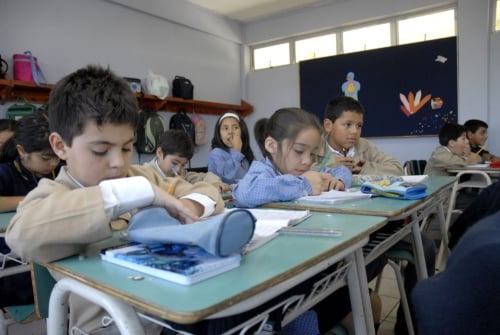https://vimeo.com/202438430
A CEO talks about the 50 different funding problems in US education
This interview is part of a series of discussions I conducted on the Financial Health of the U.S. Education System. The idea spawned from conversations I had with Jess Gartner, CEO, and founder of Allovue, a noted connector in the space bringing voices in financial management together. During the Future of Education Finance Summit, Gartner popularized the term #EdfinTech, and it has been gaining steam ever since.
Founder and CEO of EdBuild, Rebecca Sibilia
 One of the most glaring issues, when you look at education funding for our K-12 public schools across the country, is local income disparity creating haves and have nots. With education funding mostly based on local tax revenue, it stands to reason that a student in an affluent suburb north of New York City is going to grow up with a vastly different educational experience than a student in a poor inner city district in the Bronx.
One of the most glaring issues, when you look at education funding for our K-12 public schools across the country, is local income disparity creating haves and have nots. With education funding mostly based on local tax revenue, it stands to reason that a student in an affluent suburb north of New York City is going to grow up with a vastly different educational experience than a student in a poor inner city district in the Bronx.
Rebecca Sibilia is Founder and CEO of EdBuild, a non-profit organization based in Washington DC that is focused on more equitable ways for states to fund local schools. As she points out, because of a couple of key supreme court decisions, we don’t have a national school funding problem to deal with; we have 50 independent problems, one in each state.
She explains the history of the legislation and politics the led us to the position we find ourselves in regarding education funding, including the notion that the education system is actually “flush with cash” but is simply mismanaged.
Finally, Rebecca says that EdBuild is trying to “better match up the accountability and the authority for the provision of education, which rests at a state level, with how schools are being funded to bring those two issues together.” Check out the interview above to hear how they are trying to accomplish this noble goal.
Interview Transcript:
Dr. Berger: Rebecca, a lot of people, especially with the Trump transition in DC, are looking at what our education landscape is going to be and how it’s going to be impacting those that are in schools as practitioners, as students, as community members, and also those that are working to support the educational system at large.
We’ve been looking at the financial health of the US education system, and it seems like what you are doing with EdBuild is keenly tied to this area of focus. Where are we in how we look at and examine the state of the financial health of the US education system?
 Rebecca Sibilia: One of the things that I think doesn’t get enough attention, in terms of the education landscape as a whole, is the supreme court ruling in San Antonio V. Rodriguez. What the supreme court said in that case in the early 70s is that education is not a fundamental right that is guaranteed by the US Constitution. This, in essence, pushed almost all of the requirements down to the states, in terms of guaranteeing access to a great education for kids.
Rebecca Sibilia: One of the things that I think doesn’t get enough attention, in terms of the education landscape as a whole, is the supreme court ruling in San Antonio V. Rodriguez. What the supreme court said in that case in the early 70s is that education is not a fundamental right that is guaranteed by the US Constitution. This, in essence, pushed almost all of the requirements down to the states, in terms of guaranteeing access to a great education for kids.
All of the funding policy related to how schools are resourced is largely driven by state by state basis. So answering the question of how the general fiscal health of our schools is doing, really requires 50 different answers.
DB: And does therein lie the problem? We’re battling with local control versus federal oversight. From your position, is there an answer that says “we can fix this if we do X?” I know, in doing research, looking at the fault lines in these different areas that you’re designating and carving out, if we’re to establish what these fault lines are, and how to shore them up, is it from a local perspective, or do we need the federal oversight?
RS: If you want a holistic fix throughout the country, then you need to revisit two really important supreme court cases, San Antonio V. Rodriguez, and a really understated one, Milliken V. Bradley. A lot of people don’t focus on Milliken, but we actually think that it had one of the broadest sweeping impacts on education to date. What Milliken basically said is that, if there is a school district order that is drawn anywhere for any reason, by the state, that the US Supreme Court doesn’t have the authority to mandate desegregation across that school district order.
And so what in essence did, is give wide sweeping power to the states, to draw lines wherever they so chose. What we now see is that, in a lot of cases, those lines tend to be extremely segregating both a racial and a socioeconomic perspective.
If we want to see holistic change, we have to go back to the supreme court. But there are certainly things that states can do to smooth out the negative effects of school district orders.
States can move to a much more progressive way of funding schools – moving away from this reliance on local property taxes and toward a state-funded system. States can annually review their school orders to see whether or not there are drastic changes and differences between the socioeconomic status of kids.
We do that pretty regularly for electoral borders, why we don’t do it for school district borders is kind of beyond me.
And so there are a number of things that states can do, but again on in order to encourage states to do that, organizations like EdBuild have to go state by state to change those policies.
DB: Let’s talk a little bit about those alternative funding sources. There’s an ongoing argument about public-private partnerships in this country, and yet other countries are looking at ways to bring in private enterprise to public school communities. And, from my perspective, this is to great benefit to everybody who is involved.
Is there a reality that we need to come to grips with, that our children are marketed to on a daily basis, everywhere outside of school, in school, and with technology, and that there’s got to be a way to capitalize on that, in a thoughtful, systematic manner?
 RS: One of the most of the promising areas is social impact bonds. We’ve seen a few of them come to the United States. The idea is that you have a number of product investors who will make a bet on something that will eventually bring savings to the state.
RS: One of the most of the promising areas is social impact bonds. We’ve seen a few of them come to the United States. The idea is that you have a number of product investors who will make a bet on something that will eventually bring savings to the state.
There is probably no other area where investment can yield significant long term outcomes than education. The problem is that usually states are issuing social impact bonds, but the states delegate a lot of authority for how schools are being funded at the local level. And so you have a mismatch, in some cases, between where a social impact bond could sit at the state level, versus who’s actually carrying out the provision of education, which is largely the locals.
What you’re looking at in an education system is essentially 16,000 different decision makers, that is the number of school districts that we have in the US.
DB: I don’t know if that’s troubling more as a parent or as someone who’s working in education. How should we understand it from the community member perspective? If you’re at a local community event or picnic, or after school event and someone’s willing to know about what you do at EdBuild, how do you communicate it in a way that is not daunting?
I think for those of us in the industry, it is a bit daunting to think about thousands and thousands of decision makers, and local versus state and federal control, and all of the provisions or the hurdles that prevent innovators from wanting even to work or interact with the education sector.
RS: The first thing I try to do is to establish to folks the baseline — that the federal government actually does not have a lot of oversight as it relates to school district policies. Largely, states are making decisions on most of their education policy themselves. And that is being carried out at the local level. So the real line of accountability is with the state, but the state is allowing the locals to resource their schools however they’d like.
What EdBuild is trying to do is better match up the accountability and the authority for the provision of education, which rests at a state level, with how schools are being funded to bring those two issues together. But in terms of explaining this to a layperson, the notion is that for a long time, we have funded schools based on the local wealth of the community or the resources that were in the school — the teacher, the system, the computer, the pencil, the apple, everything else. What we’re looking to do is to move funding systems for the needs of students rather than the resources and the wealth of the community. And that doesn’t take a lot of work; it takes a lot of political capital at the state level.
DB: Yeah and that’s the part that I don’t think a lot of folks think that are in the industry, is just how political education is. When you first started in your career, was that eye-opening as to how political it is in the industry?
 RS: What’s actually interesting about education is that everyone has had experienced in the education system. Therefore, everyone has an opinion on whether or not schools are working. One of the things that I found throughout the course of my time is that education is not necessarily motivating people at the ballot box.
RS: What’s actually interesting about education is that everyone has had experienced in the education system. Therefore, everyone has an opinion on whether or not schools are working. One of the things that I found throughout the course of my time is that education is not necessarily motivating people at the ballot box.
You don’t often see a lot of local elected officials campaigning on education priorities. They’ll campaign on what I think are normal kind of political platforms. Education very rarely plays a significant role there. Where it does play a role is in funding. You’ll hear a lot of local officials talk about the level of funding in schools. That means that folks have to give up the notion that they will be locally funding their schools, which is almost impossible. Where it ends up really at the end of the day is a game of winners and losers.
You’ll see a lot of folks vote across party lines on education funding, depending on whether or not it is going to benefit their school and their constituents. So it is one of the areas where it’s overly political, but it’s political in a way that we normally don’t define our state and local politics. It is not a party-driven issue, education funding; this is a game of winners and losers.
DB: Speaking of that, President Trump talked about the education sector being flushed with cash but obviously mismanaged. Is that accurate from your perspective? I think that there’s this notion that we spend more per pupil than any other western country but that we obviously struggle in the results around achievement. Are we flushed with cash in education?
RS: No. I think if you would go to a lot of states and talk to a lot of teachers, who are incredibly underpaid, and they would absolutely tell you that their classrooms are not well resourced, that they are underpaid, and we are absolutely not a system that is flushed with cash.
So a couple of reasons why this is important. First, when we report education funding statistics, we don’t cost adjust. What happens is $12,000, $14,000, $15,000 in Connecticut is actually only worth let’s say $10,000. And so when we come up with these aggregate averages across the US, we’re not taking into consideration the fact that there are a number of northeastern states that are just completely blowing that average because we’re not cost adjusting for the costs there. What we found is that once we actually cost adjust, that number drops significantly.
The second thing that I would make a note of is that we do a lot of talking about the absolute investment in education. So two things about those OECD numbers, which are what’s normally reported. The first is that in some cases, they include both higher ed and K-12 education. You have to pull those two apart. The US spends a lot more on higher education than other countries, and so that’s something that skews the numbers in some cases.
 But the other number that is important is the table that’s published in the book right after the talking point. And that table is what percent of our GDP are we actually investing in education. And when you look at that number, what you’ll find is that the US runs right about middle for all industrialized countries in terms of the amount of our wealth we are investing in our education system.
But the other number that is important is the table that’s published in the book right after the talking point. And that table is what percent of our GDP are we actually investing in education. And when you look at that number, what you’ll find is that the US runs right about middle for all industrialized countries in terms of the amount of our wealth we are investing in our education system.
So it’s slightly misleading just to look at the numbers and absolutes. You have to cost adjust; you have to make sure that you’re taking into consideration wild variations in economies. But when you’re looking at a multi-national level, taking into consideration the ability of a country to pay, may be even more important than its absolute investment.
DB: So it’s about providing context and building that context into the conversation.
I want people to know that you can learn more about Rebecca at edbuild.org. You’re doing some really groundbreaking work there. And obviously, when you’re talking about 50 different states and systems within, we need people and professionals like yourself to go out and have those conversations that are obviously quite complex and unwieldy at best.
About Rebecca Sibilia:
 Rebecca Sibilia launched EdBuild in June of 2014. Prior to starting EdBuild, Rebecca served as the Chief Operating Officer and Vice President for Fiscal Strategy at StudentsFirst. In her fiscal strategy role, she led a team in analyzing per-pupil funding levels and state funding mechanisms that ensure “equity” and “adequacy” considerations. Her team also studied and made recommendations to state and district officials on directed reforms to support more innovative use of resources across the public education spectrum.
Rebecca Sibilia launched EdBuild in June of 2014. Prior to starting EdBuild, Rebecca served as the Chief Operating Officer and Vice President for Fiscal Strategy at StudentsFirst. In her fiscal strategy role, she led a team in analyzing per-pupil funding levels and state funding mechanisms that ensure “equity” and “adequacy” considerations. Her team also studied and made recommendations to state and district officials on directed reforms to support more innovative use of resources across the public education spectrum.
Prior to her work at StudentsFirst, she served as the Chief Financial Officer for the DC Office of the State Superintendent of Education, where she oversaw the investment of more than $1 billion in local, state, and federal student funding and the calculation of per-student funding based on state policy priorities. In prior roles, she created congressionally funded education programs; held state and local education policy roles; and developed venture philanthropy programs to serve low-income students in accessing quality education in appropriate settings.
Rebecca holds a Bachelor’s degree in Political Science from Clemson University and an honorary fellowship in American Government from the University of South Carolina.
This article was originally published in the Huffington Post
AuthorDr. Berger is one of many industry education correspondents for the Mind Rocket Media Group, An educator and former school administrator. His video interview work and conversational podcasts have been featured in various media outlets. He often hosts education panel discussions and develops strategic content. As an academic Dr. Berger is a guest lecturer at Vanderbilt University’s Owen Graduate School of Management. A former assistant principal, he has been an adjunct undergraduate professor and developer of online college courses. He is a passionate Detroit sports fan who has also adopted Nashville sports teams as his own.
Contact the Mind Rocket Media Group if you are interested in an industry interview and a placement on EdCircuit.
Further Reading
- WMCAction News 5 – Mississippi one of six states that doesn’t provide for ELL
- The Clarion Ledger – Senate budget officer joins EdBuild
- Sun Herald – New formula could cut funds, increase property-tax in some Coast districts
